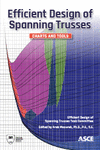Front matter for Efficient Design of Spanning Trusses
Publication: Efficient Design of Spanning Trusses: Charts and Tools
Abstract
Front matter pages come before the papers or chapters in a published work and include a title page, copyright information, and a table of contents. This publication's front matter also includes a preface and acknowledgments.
Other Titles of Interest
Constructability Concepts and Practice, edited by John A. Gambatese, James B. Pocock, and Phillip S. Dunston (ASCE/CI 2007). This report examines constructability, the integration of construction knowledge and experience in the planning, design, procurement, construction, operation, maintenance, and decommissioning phases of a project consistent with overall project objectives. (ISBN 978-0-7844-7184-5)
Failure Case Studies: Steel Structures, edited by Navid Nastar and Rui Lui (ASCE/FED 2019). This book provides a summary and review of eight steel structure failure case studies designed to promote failure literacy to improve the practice of civil engineering and to reduce risk to the public. (ISBN 978-0-7844-1530-6)
Water Engineering with the Spreadsheet: A Workbook for Water Resources Calculations Using Excel, by Ashok Pandit (ASCE Press 2016). Ashok Pandit provides more than 90 problems, from easy to difficult, in the areas of fluid mechanics, hydraulics, hydrology, and stormwater management. Using the accompanying spreadsheets, students will gain a solid foundation on the topics along with hands-on experience with Excel. (ISBN 978-0-7844-1404-0)
Engineering with the Spreadsheet: Structural Engineering Templates Using Excel, by Craig T. Christy (ASCE Press 2006). Christy provides the tools needed to quickly apply the powerful analytic capability of Microsoft Excel to structural engineering applications. (ISBN 978-0-7844-0827-8)
Dedication
This report represents several years of research and hard work of many.
But like everything, the idea had its beginning.
It started around the year 2013 with a seed—a simple conversation.
Fueled by a series of what if questions.
The person responsible for the seed to grow is William F. Baker.
I would like to dedicate this report to him.
Thank you, Bill.
Arek Mazurek
Preface
Members of the Optimal Structural Design (OSD) Committee of the Structural Engineering Institute (SEI) of the American Society of Civil Engineers (ASCE) are individuals from academia and engineering practice who are knowledgeable on topics of multidisciplinary optimization. The goal of the committee is to promote efficient structural design, efficient not only in financial terms but also when including other parameters such as time, weight, carbon footprint, and others. A task committee for Efficient Design of Spanning Trusses has been formed to focus on the publishing of this work. This publication is specifically meant to help in selecting the most efficient designs for single span structural steel trusses. However, it broadly discusses optimization procedures that could be applied to other structures. Assumptions needed to allow for the encapsulation of multiple truss designs into the series of unitless charts are also discussed.
Contributing Authors
Efficient Design of Spanning Trusses Task Committee:
Arek Mazurek, Ph.D., P.E., S.E., Chair
Oded Amir, Ph.D.
Edvard P. G. Bruun, P.Eng.
Oren Lavan, Ph.D., S.E., F.ASCE
Sanaz Saadat, Ph.D., P.E.
Jerome Tobolski, P.E., S.E., CEng.
About Charts and Tools
Design charts are included to assist engineers in making an informative initial selection of a truss. These charts can also be utilized to estimate a weight of a truss without the need of a design. Ranges of parameters considered to generate the charts have been selected to consider most of the practical structural trusses. In the event a truss falls beyond the range of the charts, the reader is encouraged to utilize the attached tools.
The attached tools are spreadsheets in MS Excel, and these have been used to generate all single topology truss charts that are attached to this report. Generating trusses that differ from these attached may require the reader to edit the spreadsheets and/or macros. The tools are provided in an open form to enable further research on the subject of the efficient design of trusses.
Acknowledgments
A special recognition goes to Jerome Tobolski for his exceptional dedication and contribution in the development of this book. His passion for engineering, attention to details, and hard work stood out and was important component in our quest for perfection.
Arek Mazurek
Information & Authors
Information
Published In

Efficient Design of Spanning Trusses: Charts and Tools
Pages: i - xii
Editor: Arek Mazurek, Ph.D.
ISBN (Print): 978-0-7844-8492-0
Copyright
© 2023 American Society of Civil Engineers.
History
Published online: Jun 6, 2023
Authors
Metrics & Citations
Metrics
Citations
Download citation
If you have the appropriate software installed, you can download article citation data to the citation manager of your choice. Simply select your manager software from the list below and click Download.